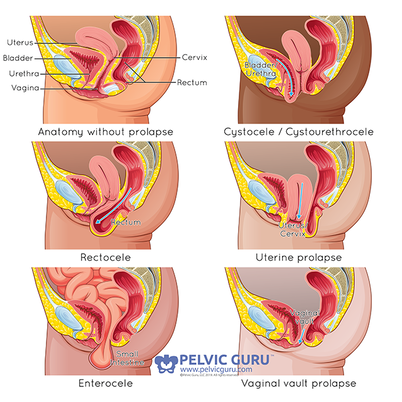Prolapse: Why Strength Training Will Not Make It Worse
Oct 13, 2022
Are you like 50% of women who have an anatomical pelvic organ prolapse? That means you may have one and you do not even know it, and that is okay! However, if you are experiencing symptoms such as heaviness in the pelvis or a bulge, this new sensation can be troubling. I’m here to tell you to have no fear because there is a lot we can do to help! One of the best things you can do is begin or return to strength training - however it needs to be at the right intensity and load for your body right now. You may be thinking, “I don’t want to pick up that heavy thing, that’s going to make my prolapse worse.” Well I am here to tell you that it will not make it worse under the right circumstances. We’re going to go over what prolapse is, why strength training is important, and 3 modifications you can implement during your resistance training.
What is pelvic organ prolapse?
Also known as POP or just prolapse, is when there is a descent of one or more of the pelvic organs toward the vaginal opening. What this is NOT is your organs falling out of the vagina. Rather, due to life circumstances such as multiple vaginal births, hysterectomy, advancing age, we can lose the internal support structure that suspends our viscera along with general core weakness. There are different kinds of prolapse where it affects more of the anterior wall of the vagina, posterior wall, or the superior wall like the roof. Regardless of your presentation, we will work to find the best ways to relieve symptoms and get you stronger.

https://www.healthymumma.com/blog/pelvic-organ-prolapse
Strength Training Helps
You may have been told that you should be careful or to not lift weights at all as it will increase pressure in your abdomen and you may bulge more. Although anything is possible, with the correct training on breathing techniques, load management and positioning, I’m here to tell you lifting weights is not only possible but it’s necessary. Having a strong core and legs in the long term will put less pressure on your pelvic floor because what was once a heavy or straining activity (i.e. getting up from the floor, picking up your toddler, picking up heavy items) will be easier with your gained strength. The pelvic floor muscles do not work in isolation and strengthening the external pelvic muscles will help reduce symptoms and increase quality of life!2
3 Modifications to Try
- Breath - exhale with exertion. For example, if you are doing a goblet squat, you are going to inhale as you lower, exhale as you stand up. If you are still feeling symptoms of heaviness at the bottom of your squat, you can try exhaling halfway through the descent and continue as you stand up. The diaphragm and pelvic floor muscles work together in breathing. Inhales make the diaphragm and pelvic floor descend, and exhales bring the diaphragm back up into the heart and lung cavity, and the pelvic floor muscles naturally follow it up. This creates a synchronous system to support you through movements or lifting heavier items.
- Alignment - ribcage over pelvis. During your workout, throughout your various movements like lunges, deadlifts, squats, planks, overhead press, etc, practice maintaining your ribcage and pelvis stacked. This is a subtle movement and requires a degree of awareness and practice. You don’t want to feel like your spine/tailbone are tucked under too much (rounded like a roly poly) or arching your back (sticking your booty out) too much during any of these movements. This can put undue strain on the pelvic floor especially under heavy loads. We want equal forces around the entire core.
- Load - decrease weight. This can be the hardest one. If you are feeling uncomfortable and your symptoms are not improving, decrease your weight. We can still alter intensity, rest breaks, depth, breath while we teach your core how to manage this movement. With the right sequence for you, you can build back up in weights to your tolerance.
By now, you can see there are plenty of options to try to keep you doing your workouts even though you may have a prolapse. Our goal in physical therapy is to keep you doing your loved activities as long as possible and feeling your best. People often ask if they need surgery for their prolapse and it depends on how much this taking away from your life in terms of bowel/bladder/sexual function and overall quality of life.3 Some individuals do well with a pessary fitting, which is an internal device that can help support the vaginal walls, or anecdotally, some women find relief with wearing a tampon, menstrual cup or flex disc while exercising to decrease symptoms successfully.
I am helping women overcome their pelvic heaviness or bulge symptoms at our clinic in Decatur, GA. Having a specific plan for your unique situation will lead to the best results. Give us a call to schedule your appointment!
In health,
Krystal Fannin PT, DPT, CMTPT, RYT-200
1Gorji, Z, Pourmomeny, AA, Hajhashemy, M. Evaluation of the effect of a new method on the pelvic organ prolapse symptoms. Lower Urinary Tract Symptoms. 2020; 12: 20– 24. https://doi.org/10.1111/luts.12277
2Maher CF, Baessler KK, Barber MD, Cheong C, Consten ECJ, Cooper KG, Deffieux X, Dietz V, Gutman RE, van Iersel JJ, Nager CW, Sung VW, de Tayrac R. Surgical management of pelvic organ prolapse. Climacteric. 2019 Jun;22(3):229-235. doi: 10.1080/13697137.2018.1551348. Epub 2018 Dec 21. PMID: 30572743.
Let us help you figure out to live your best active life today!
Remember, Movement is Medicine!

